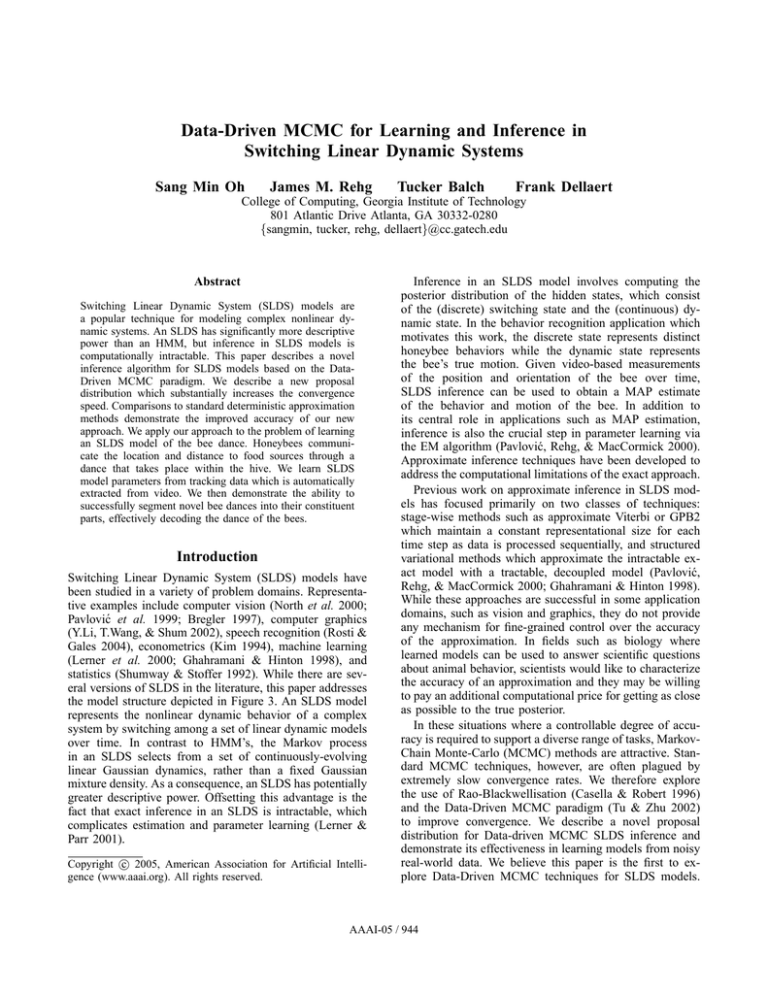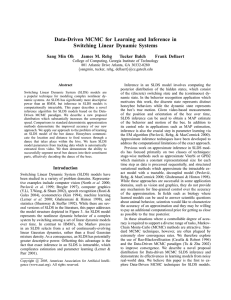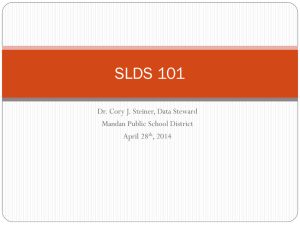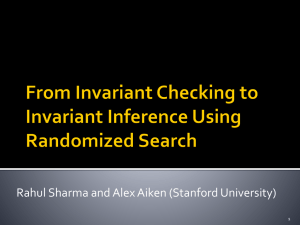
Data-Driven MCMC for Learning and Inference in
Switching Linear Dynamic Systems
Sang Min Oh
James M. Rehg
Tucker Balch
Frank Dellaert
College of Computing, Georgia Institute of Technology
801 Atlantic Drive Atlanta, GA 30332-0280
{sangmin, tucker, rehg, dellaert}@cc.gatech.edu
Abstract
Switching Linear Dynamic System (SLDS) models are
a popular technique for modeling complex nonlinear dynamic systems. An SLDS has significantly more descriptive
power than an HMM, but inference in SLDS models is
computationally intractable. This paper describes a novel
inference algorithm for SLDS models based on the DataDriven MCMC paradigm. We describe a new proposal
distribution which substantially increases the convergence
speed. Comparisons to standard deterministic approximation
methods demonstrate the improved accuracy of our new
approach. We apply our approach to the problem of learning
an SLDS model of the bee dance. Honeybees communicate the location and distance to food sources through a
dance that takes place within the hive. We learn SLDS
model parameters from tracking data which is automatically
extracted from video. We then demonstrate the ability to
successfully segment novel bee dances into their constituent
parts, effectively decoding the dance of the bees.
Introduction
Switching Linear Dynamic System (SLDS) models have
been studied in a variety of problem domains. Representative examples include computer vision (North et al. 2000;
Pavlović et al. 1999; Bregler 1997), computer graphics
(Y.Li, T.Wang, & Shum 2002), speech recognition (Rosti &
Gales 2004), econometrics (Kim 1994), machine learning
(Lerner et al. 2000; Ghahramani & Hinton 1998), and
statistics (Shumway & Stoffer 1992). While there are several versions of SLDS in the literature, this paper addresses
the model structure depicted in Figure 3. An SLDS model
represents the nonlinear dynamic behavior of a complex
system by switching among a set of linear dynamic models
over time. In contrast to HMM’s, the Markov process
in an SLDS selects from a set of continuously-evolving
linear Gaussian dynamics, rather than a fixed Gaussian
mixture density. As a consequence, an SLDS has potentially
greater descriptive power. Offsetting this advantage is the
fact that exact inference in an SLDS is intractable, which
complicates estimation and parameter learning (Lerner &
Parr 2001).
c 2005, American Association for Artificial IntelliCopyright gence (www.aaai.org). All rights reserved.
Inference in an SLDS model involves computing the
posterior distribution of the hidden states, which consist
of the (discrete) switching state and the (continuous) dynamic state. In the behavior recognition application which
motivates this work, the discrete state represents distinct
honeybee behaviors while the dynamic state represents
the bee’s true motion. Given video-based measurements
of the position and orientation of the bee over time,
SLDS inference can be used to obtain a MAP estimate
of the behavior and motion of the bee. In addition to
its central role in applications such as MAP estimation,
inference is also the crucial step in parameter learning via
the EM algorithm (Pavlović, Rehg, & MacCormick 2000).
Approximate inference techniques have been developed to
address the computational limitations of the exact approach.
Previous work on approximate inference in SLDS models has focused primarily on two classes of techniques:
stage-wise methods such as approximate Viterbi or GPB2
which maintain a constant representational size for each
time step as data is processed sequentially, and structured
variational methods which approximate the intractable exact model with a tractable, decoupled model (Pavlović,
Rehg, & MacCormick 2000; Ghahramani & Hinton 1998).
While these approaches are successful in some application
domains, such as vision and graphics, they do not provide
any mechanism for fine-grained control over the accuracy
of the approximation. In fields such as biology where
learned models can be used to answer scientific questions
about animal behavior, scientists would like to characterize
the accuracy of an approximation and they may be willing
to pay an additional computational price for getting as close
as possible to the true posterior.
In these situations where a controllable degree of accuracy is required to support a diverse range of tasks, MarkovChain Monte-Carlo (MCMC) methods are attractive. Standard MCMC techniques, however, are often plagued by
extremely slow convergence rates. We therefore explore
the use of Rao-Blackwellisation (Casella & Robert 1996)
and the Data-Driven MCMC paradigm (Tu & Zhu 2002)
to improve convergence. We describe a novel proposal
distribution for Data-driven MCMC SLDS inference and
demonstrate its effectiveness in learning models from noisy
real-world data. We believe this paper is the first to explore Data-Driven MCMC techniques for SLDS models.
AAAI-05 / 944
The Data-Driven MCMC approach has been successfully applied in computer vision, e.g., image segmentation/parsing (Tu & Zhu 2002) and human pose estimation in
still images (Lee & Cohen 2004). In data-driven approach,
the convergence of MCMC methods (Gilks, Richardson,
& Spiegelhalter 1996) is accelerated by incorporating an
efficient sample proposal which is driven by the “cues”
present in the data.
Fig. 1. (Left) A bee dance is in three patterns : waggle, left turn,
and right turn. (Right) Green boxes are tracked bees.
Moreover, we believe that these techniques are broadlyapplicable to problems in time series and behavior modeling.
The application domain which motivates this work is
a new research area which enlists visual tracking and
AI modeling techniques in the service of biology (Balch,
Khan, & Veloso 2001). The current state of biological
field work is still dominated by manual data interpretation, a time-consuming and error-prone process. Automatic
interpretation methods can provide field biologists with
new tools for quantitative studies of animal behavior. A
classical example of animal behavior and communication
is the honeybee dance, depicted in a stylized form in Fig. 1.
Honeybees communicate the location and distance to food
sources through a dance that takes place within the hive.
The dance is decomposed into three different regimes: “turn
left”, “turn right” and “waggle”.
Previously, we developed a vision system that automatically tracks the dancer bees, which are shown with
green rectangles in Fig.1. Tracks from multiple bee dances,
extracted automatically by our system, are shown in Fig.7,
where the different dance phases are illustrated in different
colors. We apply the Data-Driven MCMC techniques that
we have developed to this bee dance data and demonstrate
successful modeling and segmentation of dance regimes.
These experimental results demonstrate the effectiveness
of our new framework.
Related Work
Switching linear dynamic system (SLDS) models have been
studied in a variety of research communities ranging from
computer vision (Pavlović et al. 1999; North et al. 2000;
Bregler 1997; Soatto, Doretto, & Wu 2001), computer
graphics (Y.Li, T.Wang, & Shum 2002), and speech recognition (Rosti & Gales 2004) to econometrics (Kim 1994),
machine learning (Lerner et al. 2000; Ghahramani & Hinton 1998), and statistics (Shumway & Stoffer 1992).
Exact inference in SLDS is intractable (Lerner & Parr
2001). Thus, there have been research efforts to derive
efficient but approximate schemes. The early examples include GPB2 (Bar-Shalom & Li 1993), and Kalman filtering
(Bregler 1997). More recent examples include a variational
approximation (Pavlović, Rehg, & MacCormick 2000), expectation propagation (Zoeter & Heskes 2003), sequential
Monte Carlo methods (Doucet, Gordon, & Krishnamurthy
2001) and Gibbs sampling (Rosti & Gales 2004).
SLDS Background
A switching linear dynamic systems (SLDS) model describes the dynamics of a complex physical process by the
switching between a set of linear dynamic systems (LDS).
Linear Dynamic Systems
Fig. 2.
A linear dynamic system (LDS)
An LDS is a time-series state-space model that comprises
a linear Gaussian dynamics model and a linear Gaussian
observation model. The graphical representation of an LDS
is shown in Fig.2. The Markov chain at the top represents
the state evolution of the continuous hidden states xt .
The prior density p1 on the initial state x1 is assumed to
be normal with mean µ1 and covariance Σ1 , i.e., x1 ∼
N (µ1 , Σ1 ).
The state xt is obtained by the product of state transition
matrix F and the previous state xt−1 corrupted by the additive white noise wt , zero-mean and normally distributed
with covariance matrix Q:
xt = F xt−1 + wt where wt ∼ N (0, Q)
(1)
In addition, the measurement zt is generated from the
current state xt through the observation matrix H, and
corrupted by white observation noise vt :
zt = Hxt + vt where vt ∼ N (0, V )
(2)
∆
Thus, an LDS model M is defined by the tuple M =
{(µ1 , Σ1 ), (F, Q), (H, V )}. Exact inference in an LDS can
be done exactly using the RTS smoother (Bar-Shalom &
Li 1993).
Switching Linear Dynamic Systems
An SLDS is a natural extension of an LDS, where we
∆
assume the existence of n distinct LDS models M =
{Mi |1 ≤ i ≤ n}, where each model Mi is defined by the
LDS parameters. The graphical model corresponding to an
SLDS is shown in Fig.3. The middle chain, representing
∆
the hidden state sequence X = {xt |1 ≤ t ≤ T }, together
∆
with the observations Z = {zt |1 ≤ t ≤ T } at the bottom,
AAAI-05 / 945
Fig. 3.
posterior P (L, X|Z, Θ). The effect is the dramatic reduction of sampling space from L, X to L. This results in an
improved approximation on the labels L, which are exactly
the variables of interest in our application. This change is
justified by the Rao-Blackwell theorem (Casella & Robert
1996). The Rao-Blackwellisation is achieved via the analytic integration on the continuous states X given a sample
label sequence L(r) . In this scheme, we can compute the
probability of the r th sample labels P (L(r) |Z) up to a
normalizing constant via the marginalization of the joint
PDF :
Switching linear dynamic systems (SLDS)
is identical to an LDS in Fig.2. However, we now have
∆
an additional discrete Markov chain L = {lt |1 ≤ t ≤ T }
that determines which of the n models Mi is being used
at every time-step. We call lt ∈ M the label at time t and
L a label sequence.
In addition to a set of LDS models M , we specify two
additional parameters: a multinomial distribution π(l1 ) over
the initial label l1 and an n × n transition matrix B that
defines the switching behavior between the n distinct LDS
∆
models, i.e. Bij = P (lj |li ).
Learning in SLDS via EM
The EM algorithm (Dempster, Laird, & Rubin 1977) can
be used to obtain the maximum-likelihood parameters Θ̂.
The hidden variables in EM are the label sequence L and
the state sequence X. Given the observation data Z, EM
iterates between the two steps as in Algorithm 1.
Algorithm 1 EM for Learning in SLDS
• E-step : Inference to obtain the posterior distribution
∆
f i (L, X) = P (L, X|Z, Θi )
•
(3)
over the hidden variables L and X, using a current
guess for the SLDS parameters Θi .
M-step : maximize the expected log-likelihoods
Θi+1 ← argmax hlog P (L, X, Z|Θif i (L,X)
(4)
Θ
Above, h·iW denotes the expectation of a function (·)
under a distribution W . The intractability of the exact Estep in Eq.3 motivates the development of approximate
inference techniques.
Markov Chain Monte Carlo Inference
In this section, we introduce a novel sampling-based
method that theoretically converges to the correct posterior
distribution P (L, X|Z, Θ). Faster convergence is achieved
by incorporating a data-driven approach where we introduce proposal priors and label-cue models.
Rao-Blackwellised MCMC
In our solution, we propose to pursue the RaoBlackwellised posterior P (L|Z, Θ), rather than the joint
P (L(r) |Z)
Z
=k
∆
P (L(r) , X, Z) where k =
X
1
(5)
P (Z)
Note that we omit the implicit dependence on the model
parameters Θ for brevity. The joint PDF P (L(j) , X, Z) in
the r.h.s. of Eq.5 can be obtained via the inference in the
time-varying LDS with the varying but known parameters.
Specifically, the inference over the continuous hidden states
X in the middle chain of Fig.3 can be performed by RTS
smoothing (Bar-Shalom & Li 1993). The resulting posterior
is a series of Gaussians on X and can be effectively
integrated out.
To generate samples from arbitrary distributions we can
use the Metropolis-Hastings (MH) algorithm (Metropolis et
al. 1953; Hastings 1970), a MCMC (Gilks, Richardson, &
Spiegelhalter 1996). All MCMC methods work similarly :
they generate a sequence of samples with the property that
the collection of samples approximates the target distribution. To accomplish this, a Markov chain is defined over the
space of labels L. The transition probabilities are set up in a
very specific way such that the stationary distribution of the
Markov chain is exactly the target distribution, in our case
the posterior P (L|Z). This guarantees that, if we run the
chain for a sufficiently long time, the sample distribution
converges to the target distribution.
Algorithm 2 Pseudo-code for Metropolis-Hastings (MH)
1) Start with a valid initial label sequence
L(1) .
(r)0
2) Propose a new label sequence
L
from L(r) using
(r)0
(r)
a proposal density Q(L ; L ).
3) Calculate the acceptance ratio
0
0
P (L(r) |Z) Q(L(r) ; L(r) )
a=
P (L(r) |Z) Q(L(r)0 ; L(r) )
(6)
where P (L|Z) is the target distribution.
0
(r)0
4) If a >= 1 then accept L
, i.e., L(r+1) ← L(r) .
0
Otherwise, accept L(r) with probability min(1, a).
If the proposal is rejected, then we keep the previous
sample, i.e., L(r+1) ← L(r) .
We use the MH algorithm to generate a sequence of
samples L(r) ’s until it converges. The pseudo-code for the
MH algorithm is shown in Algorithm 2 (adapted from
(Gilks, Richardson, & Spiegelhalter 1996)). Intuitively, step
2 proposes “moves” from the previous sample L(r) to the
AAAI-05 / 946
0
next sample L(r) in0 space L, which is driven by a proposal
distribution Q(L(r) ; L(r) ). The evaluation of a and the
acceptance mechanism in steps 3 and 4 have the effect of
modifying the transition probabilities of the chain in such
a way that its stationary distribution is exactly P (L|Z).
However, it is crucial to provide an efficient proposal
Q, which results in faster convergence (Andrieu et al.
2003). Even if MCMC is guaranteed to converge, a naive
exploration through the high dimensional state space L
is prohibitive. Thus, the design of a proposal distribution
which enhances the ability of the sampler to efficiently
explore the space with high probability mass is motivated.
——————- time : 660 frames —————————————————->
Left turn˜N (−5.77; 2.72) Waggle˜N (−0.10; 3.32) Right turn˜N (5.79; 2.83)
Fig. 4. Learning phase. Three label-cue models are learned from
the training data. See text for detailed descriptions.
Temporal Cues and Proposal Priors
We propose to use Data-Driven paradigm (Tu & Zhu 2002)
where the cues present in the data provide an efficient
MCMC proposal distribution Q. Our data-driven approach
is consisted of two phases : Learning and Inference.
In the learning phase, we first collect the temporal cues
from the training data. Then, a set of label-cue models are
constructed based on the collected cues. By a temporal cue
ct , we mean a cue at time t that can provide a guess for
the corresponding label lt . A cue ct is a certain statistic
obtained by observing the data within the fixed time range
of zt . We put a fixed-sized window on the data and obtain
cues by looking inside it. Then, a set of n label-cue
∆
models LC = {P (c|li )|1 ≤ i ≤ n} are learned from the
classified cues where the cues are classified with respect
to the training labels. Here, n corresponds to the number
of existing patterns, the number of LDSs in our case. Each
label-cue model P (c|li ) is an estimated generative model
and describes the distribution of cue c given the label li .
In the inference phase, we first collect the temporal cues
from the test data without access to the labels. Then, the
learned label-cue models are applied to the cues and the
proposal priors are constructed. A proposal prior P (l˜t |ct )
is a distribution on the labels, which is a rough approximation to the true posterior P (lt |Z). When a cue ct is
obtained from a test data, we construct a corresponding
proposal prior P (l˜t |ct ) as follows :
∆
P (l˜t |ct ) =
P (c |l )
Pn t i
i=1 P (ct |li )
(7)
In Eq.7, a proposal prior P (l˜t |ct ) is obtained from the
normalized likelihoods of all labels. The prior describes the
likelihood that each label generates the cue. By evaluating
all the proposal priors across the test data, we obtain a full
∆
set of proposal priors P (L̃) = {P (l˜t |ct )|1 ≤ t ≤ T } over
the entire label sequence. However, the resulting proposal
priors were found to be sensitive to the noise in the
data. Thus, we smooth the estimates and use the resulting
distribution. The proposed approach is depicted graphically
in Fig.4,5,6 for the case of the bee dance domain.
In the honeybee dance, the change of heading angles
is derived as a cue based on prior knowledge. From the
stylized dance in Fig.1, we observe that the heading angles
will jitter but stay constant on average during the waggling,
Fig. 5.
Raw proposal priors. See text for descriptions.
Fig. 6.
Final proposal priors and the ground truth labels.
but generally increase or decrease during the right turn or
left turn phases. Note that the heading angles are measured
clockwise. Thus, a cue ct for a frame is set to be the change
of heading angles within the corresponding window.
In the learning phase, a cue window slides over the entire
angle data while it collects cues as shown at the top of
Fig.4. Then, the collected cues are classified according to
the training labels. The label-cue(LC) models are estimated
as the three Gaussians in our example, as shown at the
bottom of Fig.4. The estimated means and the standard
deviations show that the average change of heading angles
are -5.77, -0.10 and 5.79 radians, as expected. In our
example, the window size was set to 20 frames.
In the testing phase, the cues are collected from the data
as shown at the top of Fig.5. Then, the proposal priors
are evaluated based on the collected cues using Eq.7. The
resulting label priors are shown in Fig.5. A slice of colors at
t depicts the corresponding proposal prior P (l˜t |ct ). The raw
estimates overfit the test data. Thus, we use the smoothed
estimates as the final proposal priors, shown in Fig.6. At the
bottom of Fig.6, the ground truth labels are shown below
the final proposal priors for comparison. The obtained
priors provide an excellent guide to the labels of the dance
segments.
Data-Driven Proposal Distribution
The proposal priors P (L̃) and the SLDS discrete Markov
transition PDF B constitute the data-driven proposal Q. The
AAAI-05 / 947
Experimental results
Fig. 7.
Six dataset. 660, 660, 1054, 660, 609 and 814 frames
proposal scheme comprises two sub-procedures. First, it
selects a local region to update based on the proposal priors.
Rather than updating the entire sequence of a previous
sample L(r) , it selects a local region in L0(r) and then
proposes a locally updated new sample L(r ) . The local
update scheme improves the space exploration capabilities
of MCMC and results in faster convergence. Secondly, the
proposal priors P (L̃) and the discrete transition PDF B
are used to assign the new labels within a selected region.
The second step has the effect of proposing a sample which
reflects both the data and Markov properties of SLDSs. The
two sub-steps are described in detail below.
In the first step, scoring schemes are used to select a
local region within a sample. First, the previous sample
labels L(r) are divided into a set of segments at a regular
interval. Then, each segment is scored with respect to the
proposal priors P (L̃), i.e. the affinities between the labels
in each segment and the proposal priors are evaluated.
Any reasonable affinity and scoring schemes are applicable.
Finally, a segment is selected for an update via sampling
based on the inverted scores.
In the second step, new labels lt0 ’s are sequentially
assigned within a selected segment using the assignment
∆
0
0
function in Eq.8 where Blt0 |lt−1
= P (lt0 |lt−1
). The implicit
˜
dependence of lt on ct is omitted for brevity.
(
P (lt0 )
= βδ(lt ) + (1 − β)
0
Blt0 |lt−1
P (l˜t0 )
Pn
lt0 =1
0
Blt0 |lt−1
P (l˜t0 )
)
(8)
Above, the first term with the sampling ratio β denotes
the probability to keep the previous label lt , i.e. lt0 ← lt .
The second term proposes a sampling of a new label lt0 .
The Markov PDF B adds the model characteristics to a new
sample. Consequently, the constructed proposal Q proposes
samples that nicely embrace both the data and the intrinsic
Markov properties. Then, MH algorithm balances the whole
MCMC procedure in such a way that the MCMC inference
on P (L|Z) converges to the true posterior.
The experimental results on real-world bee data show
the benefits of the new DD-MCMC framework. Six
bee dance tracks in Fig.7 are obtained using a visionbased bee tracker. The observation data is a timeseries sequence of four dimensional vectors zt =
T
[xt , yt , cos(θt ), sin(θt )] where xt ,yt and θt denote the 2D
coordinates of bees and the heading angles. Note from Fig.7
that the tracks are noisy and much more irregular than the
idealized stylized dance shown in Fig.1. The red, green
and blue colors represent right-turn, waggle and left-turn
phases. The ground-truth labels are marked manually for
comparison and learning purposes. The dimensionality of
the continuous hidden states was set to four.
Given the relative difficulty of obtaining accurate data,
we adopted a leave-one-out strategy. The SLDS model
and the label-cue models are learned from five out of
six datasets, and the learned models are applied to the
left-out dataset for automatic labeling. We interpreted the
test dataset both by the proposed DD-MCMC method
and the approximate Viterbi method for comparison. We
selected the approximate Viterbi method as it known to
be comparable to the other methods (Pavlović, Rehg, &
MacCormick 2000). On average, 4,300 samples were used
until the convergence for all the datasets.
Fig.8 shows an example posterior distribution P (L|Z)
which is discovered from the first dataset using the proposed DD-MCMC inference. The discovered posterior explicitly shows the uncertainties embedded in data. Multihypotheses are observed in the regions where the overlayed
data shows irregular patterns. For example, around the two
fifths from the right in Fig.8, the tracked bee systematically
side-walks to the left due to the collision with other bees
around it for about 20 frames while it was turning right.
Consequently, the MCMC posterior shows the two eminent
hypotheses for those frames : 70% turn left (blue) and 30%
turn right (right) roughly.
Fig. 8.
Posterior distribution is discovered from Data 1.
The DD-MCMC is a Bayesian inference algorithm.
Nonetheless, it can be used as a robust interpretation
method. The MAP label sequence are taken from the
discovered posterior distribution P (L|Z). The resulting
MCMC MAP labels, the ground-truth, and the approximate
Viterbi labels for Data 1 are shown from the top to
bottom in Fig. 9. It can be observed that DD-MCMC
delivers solutions that concur very well with the ground
truth. On the other hand, the approximate Viterbi labels at
the bottom over-segments the data (insertion errors). The
insertion errors of approximate Viterbi highlight one of
the limitations of the class of deterministic algorithms for
SLDS. In this respect, the proposed DD-MCMC inference
method is shown to improve upon the Viterbi result and
AAAI-05 / 948
Fig. 9.
Data 1 : DD-MCMC MAP, ground truth, Viterbi labels.
Errors
Insertions
D1
7/14
D2
5/6
D3
2/5
D4
3/4
D5
1/1
D6
0/0
TABLE I
MCMC MAP / V ITERBI E RROR STATISTICS
provide more robust interpretation (inference) capabilities.
The insertion errors induced by DD-MCMC MAP/Viterbi
for all six datasets are summarized in Table.I.
Some errors between the MAP labels and the ground
truth occur due to the systematic irregular motions of the
tracked bees. In these cases, even an expert biologist will
have difficulty figuring out all the correct dance labels soley
based on the observation data, without access to the video.
Considering that SLDSs are learned exclusively from the
observation data, the results are fairly good.
Conclusion
We introduced a novel inference method for SLDS. The
proposed method provides a concrete framework to a
variety of research communities. First, it can characterize
the accuracy of deterministic approximation algorithms.
Secondly, it serves as an inference method that can discover
true posteriors. This leads to a robust inference and learning. Finally, DD-MCMC delivers correct MAP solutions to
a wide range of SLDS applications.
The proposed method efficiently converges to the posterior, overcoming a potential limitation of MCMC methods.
The efficiency is achieved via the sampling space reduction by Rao-Blackwellisation and the data-driven approach
where temporal cues and proposal priors are introduced to
construct an efficient proposal.
In terms of characteristics, DD-MCMC inference method
embraces data characteristics and model-based approaches.
The characteristics of data are effectively learned using the
temporal cues where the form of the cues are obtained from
prior knowledge.
The authors believe that this work is the first to explore
Data-Driven MCMC techniques for SLDS. Moreover, the
proposed framework is broadly-applicable to problems in
time series and behavior modeling.
References
Andrieu, C.; de Freitas, N.; Doucet, A.; and Jordan, M. I. 2003.
An introduction to MCMC for machine learning. Machine
learning 50:5–43.
Balch, T.; Khan, Z.; and Veloso, M. 2001. Automatically
tracking and analyzing the behavior of live insect colonies. In
Proc. Autonomous Agents 2001.
Bar-Shalom, Y., and Li, X. 1993. Estimation and Tracking:
principles, techniques and software. Boston, London: Artech
House.
Bregler, C. 1997. Learning and recognizing human dynamics in
video sequences. In IEEE Conf. on Computer Vision and Pattern
Recognition (CVPR).
Casella, G., and Robert, C. 1996. Rao-Blackwellisation of
sampling schemes. Biometrika 83(1):81–94.
Dempster, A.; Laird, N.; and Rubin, D. 1977. Maximum
likelihood from incomplete data via the EM algorithm. Journal
of the Royal Statistical Society, Series B 39(1):1–38.
Doucet, A.; Gordon, N. J.; and Krishnamurthy, V. 2001. Particle
filters for state estimation of jump Markov linear systems. IEEE
Trans. Signal Processing 49(3).
Ghahramani, Z., and Hinton, G. E. 1998. Variational learning for
switching state-space models. Neural Computation 12(4):963–
996.
Gilks, W.; Richardson, S.; and Spiegelhalter, D., eds. 1996.
Markov chain Monte Carlo in practice. Chapman and Hall.
Hastings, W. 1970. Monte Carlo sampling methods using
Markov chains and their applications. Biometrika 57:97–109.
Kim, C.-J. 1994. Dynamic linear models with Markovswitching. Journal of Econometrics 60.
Lee, M., and Cohen, I. 2004. Human upper body pose estimation
in static images. In Eur. Conf. on Computer Vision (ECCV).
Lerner, U., and Parr, R. 2001. Inference in hybrid networks:
Theoretical limits and practical algorithms. In Proc. 17th Annual
Conference on Uncertainty in Artificial Intelligence (UAI-01),
310–318.
Lerner, U.; Parr, R.; Koller, D.; and Biswas, G. 2000. Bayesian
fault detection and diagnosis in dynamic systems. In Proc. AAAI.
Metropolis, N.; Rosenbluth, A.; Rosenbluth, M.; Teller, A.; and
Teller, E. 1953. Equations of state calculations by fast computing
machine. Journal of Chemical Physics 21:1087–1091.
North, B.; Blake, A.; Isard, M.; and Rottscher, J. 2000. Learning
and classification of complex dynamics. IEEE Trans. Pattern
Anal. Machine Intell. 22(9):1016–1034.
Pavlović, V.; Rehg, J.; Cham, T.-J.; and Murphy, K. 1999. A
dynamic Bayesian network approach to figure tracking using
learned dynamic models. In Intl. Conf. on Computer Vision
(ICCV).
Pavlović, V.; Rehg, J.; and MacCormick, J. 2000. Learning
switching linear models of human motion. In Advances in Neural
Information Processing Systems (NIPS).
Rosti, A.-V., and Gales, M. 2004. Rao-blackwellised Gibbs
sampling for switching linear dynamical systems. In Intl. Conf.
Acoust., Speech, and Signal Proc. (ICASSP), volume 1, 809–812.
Shumway, R., and Stoffer, D. 1992. Dynamic linear models
with switching. Journal of the American Statistical Association
86:763–769.
Soatto, S.; Doretto, G.; and Wu, Y. 2001. Dynamic Textures.
In Intl. Conf. on Computer Vision (ICCV), 439–446.
Tu, Z., and Zhu, S. 2002. Image segmentation by data-driven
Markov chain Monte Carlo. IEEE Trans. Pattern Anal. Machine
Intell. 24(5):657–673.
Y.Li; T.Wang; and Shum, H.-Y. 2002. Motion texture : A
two-level statistical model for character motion synthesis. In
SIGGRAPH.
Zoeter, O., and Heskes, T. 2003. Hierarchical visualization of
time-series data using switching linear dynamical systems. IEEE
Trans. Pattern Anal. Machine Intell. 25(10):1202–1215.
AAAI-05 / 949









